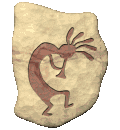| Chapter 1 | Chapter 2 | Chapter 3 | Chapter 4 | Chapter 5 | Chapter 6 | Chapter 7 | Chapter 8 | Chapter 9 |

The Hohokam were the first irrigation farmers in the southwest. They did not rely only on rain to water their crops. Instead they dug canals and brought water from the rivers. They grew cotton, cotton, beans, and squash. Workers built a dirt or rock dam across the river. The water rose higher behind the dam until it formed a small lake. Workers dug canals with stone and wooded tools. They carried the dirt away in baskets. They dug many miles of canals. The water flowed into the canals from the Gila and Salt Rivers
Cactus for Dinner
The Hohokam ate many different plants. One was the prickly pear cactus. People took off the prickly needles and baked the cactus in pits. Then it was ready to eat. The people also ate deer, lizards, mice, squirrels, turtles and rabbits.
Villages
The largest Hohokam village was in Snaketown. Most of the people there lived in pit houses. A family dug a pit in the ground. Then they built the frame out of large logs. They covered the frame with brush and mud. The house was cool in the summer and warm in the winter.. Some of the houses were small and some were quite large. The Hohokam later built pueblos. Many families lived there. One large pueblo was Casa Grande. Today it is a national monument. Casa Grande means "big house".
View 3-D Images of Hohokam pit houses
Arts and Crafts
The Hohokam made beautiful jars, bowls and pots. They also wove cotton into cloth. They made clay figures. They carved jewelry out of bone. They traded with other tribes to get seashells, and other items used in their artwork.
The Hohokam learned to etch. They drew a design on a shell with pitch. Pitch is the sticky sap of a pine tree. The design was usually of an animal such as the toad. Then they soaked the shell in acid made from cactus fruit. The part of the shell not carved with pitch was eaten away by the acid to show the design.
Hohokam means "those who have vanished". No one knows why the Hohokam left their villages. Their farmland may have been flooded, or irrigation may have made the soil to salty to grow crops. Maybe a great flood ruined their dams and canals. Maybe they left because of disease or war.
The Hohokam probably stayed somewhere in the desert region. Many archeologists believe that the Hohokam are ancestors of the modern Pima and Tohono O'odham tribes. An ancestor is a family member who lived long ago.
![]() Learn
more about the Hohokam people
Learn
more about the Hohokam people
Return to Chapter 3 Outline Return to Top